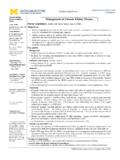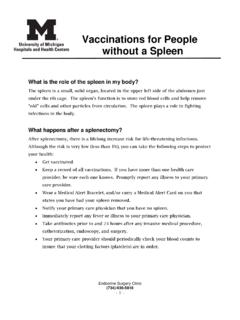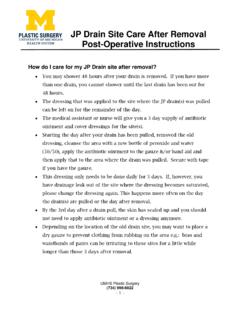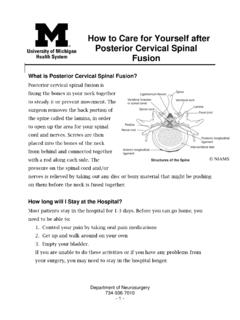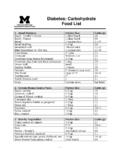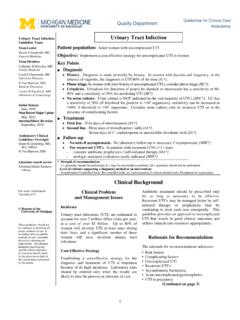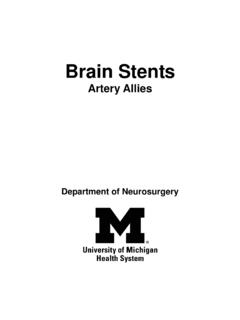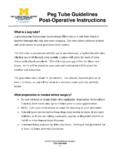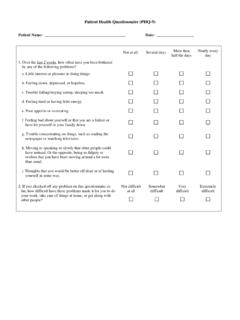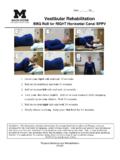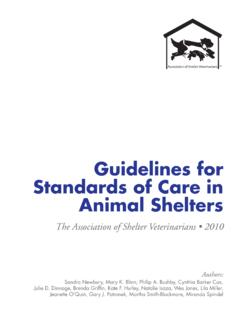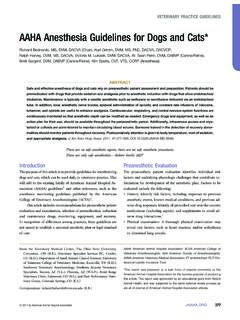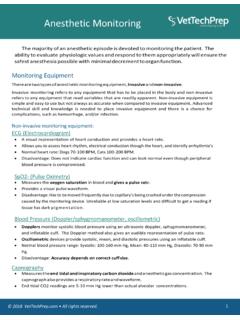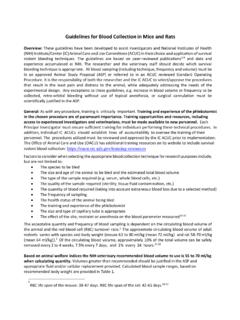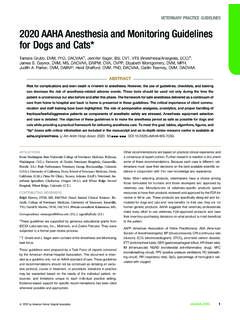Transcription of TREATMENT OF ANIMAL BITES IN PATIENTS ADMITTED TO ...
1 TREATMENT OF ANIMAL BITES IN PATIENTS ADMITTED TO PEDIATRIC SERVICES Indications for antimicrobial therapy for ANIMAL BITES (including human): Cat bite wounds Moderate or severe bite wounds (especially if edema or crush injury) Puncture wounds, especially if penetration of bone, tendon sheath, or joint Deep or surgically closed facial bite wounds Hand and foot bite wounds Genital area bite wounds Immunocompromised or asplenic Wounds with signs of infection Pediatric Infectious Disease consultation is strongly recommended for PATIENTS with complicated infections (asplenic/immunocompromised PATIENTS , infections involving CNS or bones and joints, moderate/severe wounds which injuries extend beyond soft tissue involvement, etc.)
2 Pre-emptive and Empiric TREATMENT Antimicrobial therapy ANIMAL and Usual Organism Oral Therapy Intravenous Therapy Duration Comments Dog Pasteurella canis Capnocytophaga canimorsus S. aureus Fusobacterium spp. Oral flora Cat Pasteurella multocida Staphylococcus spp Oral flora Human Viridans streptococcus Staph epidermidis Corynebacterium sp. Staph aureus Eikenella sp. Bacteroides sp. Peptostreptococcus sp. Oral flora Preferred: Amoxicillin-clavulanate 25 mg amoxicillin/kg/dose PO BID (max: 875 mg amoxicillin/dose) PCN allergy: Clindamycin 10 mg/kg/dose PO TID (max: 450 mg/dose) + TMP-SMX 5 mg/kg/dose PO BID (max: 160 mg/dose) Preferred: Ampicillin-sulbactam 50 mg ampicillin/kg/dose IV q6h (max: 2 g ampicillin/dose) Low1/Medium2-risk PCN allergy: Ceftriaxone 50 mg/kg/dose IV q24h (max: 1 g/dose) + Clindamycin 10 mg/kg/dose IV (max: 600 mg/dose) High3-risk PCN allergy: Clindamycin 10 mg/kg/dose IV (max.)
3 600 mg/dose) + Levofloxacin <5 years: 10 mg/kg/dose IV/PO q12h 5 years: 10 mg/kg/dose q24h (max: 750 mg/dose) Pre-emptive 3 days Mild infection 5 days Complicated infections 10-14 days Recommend ID consult Elevation is required if any edema is present. Lack of elevation is a common cause of therapeutic failure. For serious infections, addition of MRSA coverage is reasonable until MRSA is excluded especially in human BITES . Dog BITES in PATIENTS with asplenia, chronic alcoholism, chronic liver disease, immunosuppression are at high risk of severe sepsis due to Capnocytophaga canimorsus Monkey BITES Similar to human flora From the genus Macaca (macaque monkeys only) B Virus (herpesvirus 1) Macaque BITES , scratches, infected tissue exposure, needlestick injuries, cage scratches, and mucosal splash have been associated transmission to humans Antibacterial therapy.
4 See dog/cat/human bite above Antiviral postexposure prophylaxis (indicated in all macaque B virus exposures): Valacyclovir 20 mg/kg PO TID (max: 1,000 mg/dose) Antiviral TREATMENT with CNS symptoms present: Ganciclovir 5 mg/kg IV q12h Antiviral TREATMENT without CNS symptoms present: Acyclovir 15 mg/kg IV q8h Require additional work-up for Macacine herpes virus4 Antiviral postexposure prophylaxis: 14 days Antiviral TREATMENT : Until symptom resolution and 2 cultures are negative for B virus, then stepdown to 6 - 12 months post-exposure prophylaxis Page 2 of 5 Pre-emptive and Empiric TREATMENT Antimicrobial therapy ANIMAL and Usual Organism Oral Therapy Intravenous Therapy Duration Comments Non-meat eaters Pig Ferrets / weasels Horse Sheep Raccoons Skunks Same as dog/cat/human Same as dog/cat/human Pre-emptive 3 days Mild infection 5 days Complicated infections 10-14 days Recommend ID consult In 2015 according to the CDC.
5 5,508 cases of ANIMAL rabies were reported, involved wildlife. Major ANIMAL groups were as follows: Bats Raccoons Skunks Foxes Cats Cattle Dogs Meat eaters Bears Coyote / Wolf Bobcat Fox Same as reptiles Same as reptiles Reptiles (Iguana, turtle, lizard) Oral flora Salmonella spp Yersinia spp S. marcescens Aeromonas spp Preferred: Amoxicillin-clavulanate 25 mg amoxicillin/kg/dose PO BID (max: 875 mg amoxicillin/dose) Low1/Medium2-risk PCN allergy: Cefpodoxime 5 mg/kg/dose PO BID (max: 400 mg/dose) + Metronidazole 10 mg/kg/dose PO TID (max: 500 mg/dose) High3-risk PCN allergy: Metronidazole 10 mg/kg/dose PO TID (max: 500 mg/dose) + Levofloxacin <5 years: 10 mg/kg/dose IV/PO q12h 5 years: 10 mg/kg/dose IV/PO q24h (max.)
6 750 mg/dose) Preferred Piperacillin-tazobactam 75 mg piperacillin/kg/dose IV q6h (max: 4 g piperacillin/dose) Low1/Medium2-risk PCN allergy: Ceftriaxone 50 mg/kg/dose IV q24h (max: 1 g/dose) + Metronidazole 10 mg/kg/dose IV q8h (max: 500 mg/dose) High3-risk PCN allergy: Metronidazole 10 mg/kg/dose IV q8h (max: 500 mg/dose) + Levofloxacin <5 years: 10 mg/kg/dose IV/PO q12h 5 years: 10 mg/kg/dose q24h (max: 750 mg/dose) For serious infections, addition of MRSA coverage is reasonable until MRSA is excluded. Snake bites5 Oral flora Fecal flora of ingested prey Staphylococcus spp.
7 Streptococci Escherichia coli Morganella morganii Enterococcus faecalis Pseudomonas aeruginosa ED Snake Bite Envenomation Protocol Preferred: Amoxicillin-clavulanate 25 mg amoxicillin/kg/dose PO BID (max: 875 mg amoxicillin/dose) + Ciprofloxacin 15 mg/kg/dose PO BID (max: 750 mg/dose) PCN allergy: Ciprofloxacin 15 mg/kg/dose PO BID (max: 750 mg/dose) + Metronidazole 10 mg/kg/dose PO TID (max: 500 mg/dose) + Linezolid <12 years: 10 mg/kg/dose PO TID 12 years: 600 mg PO BID Preferred Piperacillin-tazobactam 75 mg piperacillin/kg/dose IV q6h (max: 4 g piperacillin/dose) PCN Allergy Vancomycin per dosing guideline + Aztreonam 40 mg/kg/dose IV q8h (max: 2 g/dose) + Metronidazole 10 mg/kg/dose IV q8h (max: 500 mg) Only a minority of snake BITES become infected and need antibiotics.
8 Antibiotics should be determined by culture results. Most infections of snakebites are associated with the introduction of pathogenic bacteria during attempts at management in the field. For serious infections, addition of MRSA coverage is reasonable until MRSA is excluded. Page 3 of 5 Pre-emptive and Empiric TREATMENT Antimicrobial therapy ANIMAL and Usual Organism Oral Therapy Intravenous Therapy Duration Comments Rat Streptobacillus moniliformis (USA) Spirillium minus (Asia) Recommend ID consult for follow up purposes If no evidence of infection prophylactic antibiotics can be considered Penicillin VK <12 years: 15 mg/kg/dose PO QID (max: 500 mg/dose) 12 years: 500 mg PO QID OR Doxycycline mg/kg/dose PO BID (max.)
9 100 mg/dose) Duration 3 days Up to 10% of rat BITES can lead to infection. S. moniliformis can also be carried by hamsters and other laboratory rodents. Handling of a dead rat has been reported to cause rat bite fever. Can observe if decide not to use antibiotics as most PATIENTS will present within 7 days. If clinical evidence of infection Penicillin 50,000 units/kg/dose IV q4h (max: 2 million units/dose) OR Ceftriaxone 50 mg/kg/dose IV q24h (max: 1 g/dose) OR Doxycycline mg/kg/dose PO BID (max: 100 mg/dose) Duration 10-14 days for uncomplicated infections Empiric Vaccination Recommendations ANIMAL Organism Vaccination indications Vaccination Recommendations ALL Clostridium tetani (tetanus) Those vaccinated <5 years ago with DTaP, Tdap, or Td revaccination is not indicated Those vaccinated >5 years ago or never vaccinated, vaccination is indicated Never received Tdap: Tdap (ADACEL ) IM x1 dose If previously vaccinated with Tdap.
10 Td (TENIVAC ) IM x1 dose If severe or uncleaned wound and 2 previous vaccines (or unknown vaccination history): Tetanus Immune Globulin (HYPERTET )6 250 units IM x1 dose Bats, Raccoons, Skunks, Foxes, Coyotes, Mongooses, Woodchucks, Dogs, Cats, Ferrets, Most other carnivores7 Lyssavirus spp. (rabies) Contact health department for further direction on ANIMAL containment and testing (see below text for instructions) If the
